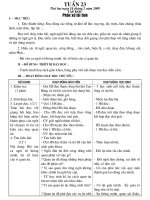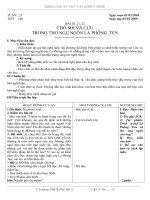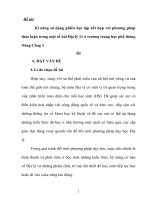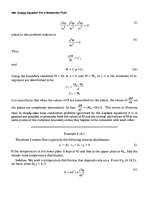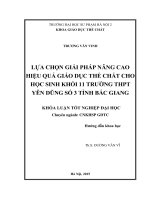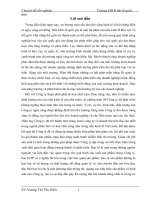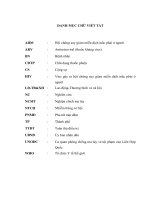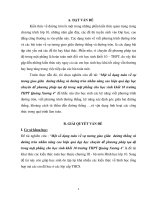11 abalone introduction methods thao (23 3 2015)
Bạn đang xem bản rút gọn của tài liệu. Xem và tải ngay bản đầy đủ của tài liệu tại đây (70.06 KB, 3 trang )
Abalone: Introduction, Objectives of study, Materials & Methods, Expected Output,
References
1. Introduction
Abalone (Haliotis) is a mollusk genus that belonged to gastropod
class. Abalone was a popular export product. It was favorite and luxury
food among people in many countries such as Japan, China, Europe
Countries United States and Canada. Because its delicious meat with
high nutritional values.
Market demand was high and increased, therefore, abalone was
continually exploited and subjected to the reduction of population
(Maliao et al., 2004). The preservation of abalone resources must need
management actions, including the management of fishing, the closure
of fishing region and season, the limitation of work quantity and fishing
outcome, or the prevail of quota system (Gulland, 1977). However,
cultivation was a solution that was recently coming into consideration.
Abalone cultivation was always possible if the seed was available
in constant. To obtain the seed in constant, thus, seeding was needed.
However, a main problem in abalone seeding was lack of availability of
broostocks. A location that is expected to become the producer of local
abalone prime is Namdu Islands, an island cluster in the west coast of
Vietnam. Coral reefs were surrounding this archipelago.
2. Objectives of study
The objectives of study is to determine the biology, growth allometry, minimum
size at sexual maturity, to measure fecundity, and to monitor histologically the
reproductive cycle of population of the abalone in Namdu archipelago, Kiengiang
province.
3. Research Methods
Survey on the exploination and resource
A number of 30 survey forms will be distributed independently to the fisherman,
who is concerning to the ablone exploination or trade. Questionaire will be focused on the
change of abalone resource in last 5 years and it will be necessary for the management
plans to maitain or develop the ablone prime in Namdu Islands.
Biology and reproduction of abalone
1
Sampling will be conducted for one year starting from January 2017 to December
2017. Samples of 20-30 abalones will be collected monthly from a subtidal population at
the Namdu archipelago, Kiengiang province to transport alive to the laboratory in Cantho
university.
Shell length in millimeters, total weight, shell weight, and shucked body weight in
grams, sex, and remarks concerning macroscopic features were recorded for each
specimen. From each specimen, two pieces of conical appendage, consisting of digestive
gland and surrounding gonad, will be excised from the tip and the midportion. Excised
pieces will be fixed and stored in neutral formalin for at least 2 days. Tissue will be
processed in an Autotechnicon and then stained with Haematocyline and Eosin. At least
three slides will be processed for each piece of gonad and examined histologically. Slides
will be observed undermicroscope, the numerial scales of gonad index will be refered
from Hadijah et al. (2013) with six differential stages as followed: Immature; Proliferated;
Maturing; Ripe; Partially spawned; Totally spawned.
Reproductive biological parameters will be also measured at the
laboratory. Parameters that will be observed are: (a) sex ratio, (b)
gonad microscopic character, (c) gonad maturity rate, (d) gonad
maturity index, (e) reproductive cycle, (f) abalone fecundity, (g)
Relationship between total fecundity and shell length.
Sex ratio will be calculated based on the comparison of male and
female samples in every month. Macroscopically, abalone gonad was
positioned in the right section across the hollowed part of shell. At the
maturity stage, female gonad was bluish green, while male gonad was
whitish cream.
Basic environmental conditions
Basic environmental conditions such as temperature, salinity,
wind direction, flow rate, structure of bottom sediment, present of
seaweeds or aquatic plants will be recorded at the same time with
abalone samplings.
4. Expected outcomes
i.
Basic environmental conditions relating to abalone distribution and
reproduction
ii.
Growth allometry
iii. Abalone exploination trends
2
i.
ii.
iii.
iv.
v.
Sex ratio (versus sampling period and size classes)
Gonad macroscopic character
Gonad microscopic character
Reproductive cycle
Abalone fecundity
5. References
Hadijah, Ambo Tuwo, Magdalena Litaay, Erni Indrawati. 2013. The Reproductive
Aspect of Tropical Abalone (Haliotis asinina L.) in the Waters of Tanakeke Islands at
South Sulawesi. Aquatic Science and Technology. ISSN 2168-9148. Vol. 1, No. 2:
Pages 30-42.
Campbell, A., Lessard, J., & Jamieson, G. S. 2003. Fecundity and seasonal
reproduction of northern abalone, Haliotis kamtschatkana, In Barkley Sound, Canada.
Journal of Shellfish Research, 22(3): Pages 811-818.
Maliao, R. J., Webb, E. L., & Jensen, K. R. 2004. A survey of stock of the donkey’s
ear abalone, Haliotis asinina L. in the Sagay Marine Reserve, Philippines: evaluating the
effectiveness of marine protected area enforcement. Fisheries Research, 66: Pages 343353.
Gulland, J. A. 1977. Fish population dynamics. London: John Wiley and Sons
3

